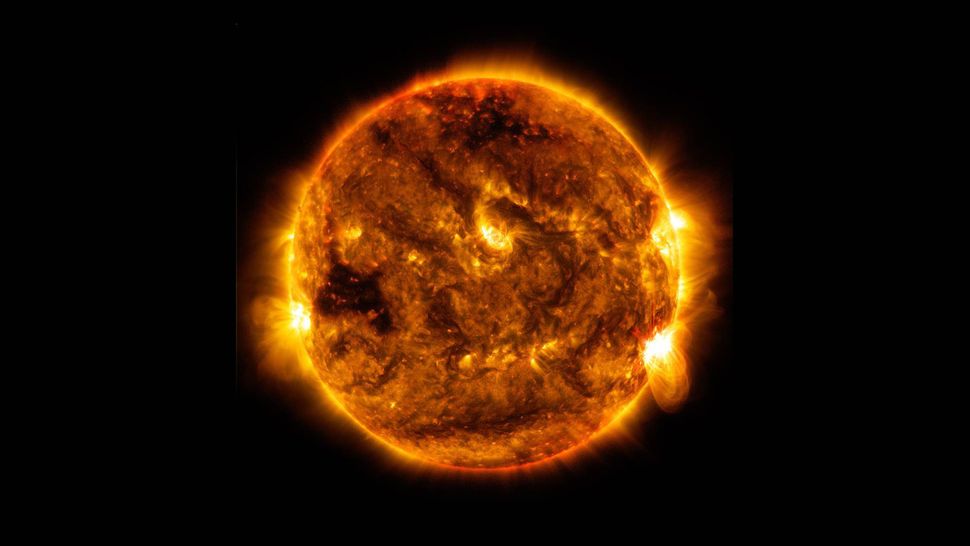Science
Related: About this forumGiant blob of solar plasma could 'graze' Earth this weekend, NOAA says
By Brandon Specktor published 1 day ago
If the solar storm hits Earth, it could drive the aurora much further south than usual.

NASA’s Solar Dynamics Observatory caught an image of a mid-level solar flare emitted by the sun on Oct. 1, 2015. (Image credit: NASA/SDO)
A weak solar storm could brush past Earth on Saturday (May 7), potentially leading to minor radio blackouts, the National Oceanic and Atmospheric Administration (NOAA) reported in a new space weather forecast.
Continuing a months-long spate of heightened activity, the sun is currently crackling with powerful solar flares, which are often accompanied by giant explosions of plasma known as coronal mass ejections (CMEs). When CMEs pass over Earth, they can temporarily compress our planet's magnetic shield, resulting in geomagnetic storms that can knock out power grids, muddle radio waves and damage satellites in their path.
The vast majority of geomagnetic storms are mild, according to NOAA. But the largest CMEs can trigger much more devastating storms — such as the infamous 1859 Carrington Event, which induced such strong electrical currents that telegraph equipment burst into flame, according to NASA. Some scientists have warned that another solar storm of that magnitude could plunge Earth into an "internet apocalypse," knocking nations offline for weeks or months, Live Science previously reported.
There is a small chance that a small CME could "graze Earth's magnetosphere" on Saturday, NOAA said in their latest report, resulting in a G1-class geomagnetic storm — the weakest class of storm on NOAA's five-level scale. When a G1 storm hits, weak power grid fluctuations can occur, and the aurora — a phenomenon caused by charged particles in solar wind colliding with molecules in Earth's atmosphere — can be seen at lower latitudes than usual. CMEs typically take 15 to 18 hours to reach Earth after they leave the sun.
More:
https://www.livescience.com/minor-solar-storm?utm_source=SmartBrief&utm_medium=email&utm_campaign=368B3745-DDE0-4A69-A2E8-62503D85375D&utm_content=7EC11E75-80D0-4669-AE41-C0581AFD9B10&utm_term=6a377ba9-3a30-44fc-a067-1f235cbe9c0f
lastlib
(24,902 posts)"Don't make me come over there"?
Pobeka
(4,999 posts)I've never seen the aurora borealis. I'll add this to another multitude of near misses.
AllaN01Bear
(23,042 posts)2naSalit
(92,669 posts)But the past few years t seems to be that a three day storm is covering my region whenever something cool in the sky is going on, like this event. We are due for a rain/snow! event that will run into late next week. So anything like star gazing or aurora watching is not going to happen.
bluedigger
(17,148 posts)Last edited Sat May 7, 2022, 01:37 PM - Edit history (1)
And, in my area, we have "No mow May" campaign to benefit pollinators. People refraining from first mowing until June helps many pollinators by not chopping them up in their springtime hidey holes.
bluedigger
(17,148 posts)Now or never situation...
You gotta do what you gotta do. I was just mentioning that in some areas...
Tall grass that you describe does present fire hazard for starters.
bluedigger
(17,148 posts)They like the fruit trees here. And only stung me three times last summer. Life in the ecosystem, lol.
2naSalit
(92,669 posts)Not only getting stung a few times with that many bees nearby.
Several years ago I was helping at a farm and there were honey bees all over the place, the crop had pollinated and when bundles of the crop came to me, I had to begin processing it and the stuff was covered in bees, hundreds at a time! I'm normally apprehensive about being too close to things that sting but these bees left me alone, they just wanted the pollen. It was surreal.
I only got one bite, not a sting, and that was because I had put a bunch of plants under my arm to carry them a short distance and there was a bee in there so it bit me, didn't hurt much or very long. Our local honey bees are pretty passive for bees.
2naSalit
(92,669 posts)It has lots of visuals.
https://www.swpc.noaa.gov/communities/space-weather-enthusiasts